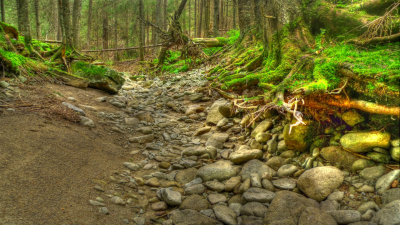 2006
2006
 2008
2008
 2010
2010
 2012
2012
 2014
2014



 |
Rivers of the Tatra Mountains – everyday risk of floods
FLORIST ‘Flood risk on the northern foothills of the Tatra Mountains, Polish – Swiss Research Program’ Nr PSPB-153/2010
Ryszard J. Kaczka – author of photographs and project manager History ready for reading The calm between floods |

|
Description popularizing the research project
When a ship was going to sink rats were always the first to know it. When they had abandoned a ship it was an undisputable signal for evacuation as the fate of the vessel had been already decided. The same was with canaries. The small singing birds saved many miners’ lives. Miners took them underground not for their beautiful voice. They simply fell silent when the workings were filled with toxic gases. Such a sign could not be ignored. Canaries’ extraordinary sensitivity and rats’ mysterious sixth sense were often the only ‘device’ warning of the coming disaster.
In the past behaviour of animals was verified by people who, for generations, knew and sensed the signals sent by the nature. They guessed coming droughts, rains and late winters. Nowadays the experience of oldest highlanders fails in confrontation with global warming and violent weather phenomena. Changes, even dynamic ones, lead to similar consequences like e.g. violent floods in mountainous regions. Hitherto observations really matter. A precise description of a flood long ago with the following changes in the soil and plants, and amount and frequency of rainfalls allows creating a system supporting analyses of the phenomena in the years to come. Combining data stored in archives with weather forecasts for the areas particularly struggling with the water element may replace rats and canaries. It should be enough to send a warning about the oncoming wave, when it is already too late for any help, or even foresee a flood looking far into the future even decades ahead.
It is hard to overestimate importance of such a warning system when many disasters, such as floods, are still unavoidable, destroying infrastructure and threatening lives of residents. Realistic assessment of the risk will allow taking flood prevention measures proportional to the frequency and intensity of rainfalls. According to climatologists, there will be only more floods in the future. Yet wise application of the system for analyzing available data means the floods will not be such a surprise for people and the animals gifted with the sixth sense alike.
Abstract
The Florist project deals with evaluation of flood risk on the northern foothills of the Tatra Mountains, where consider-able flood generation potential exists. There is a flood risk in all right-hand tributaries to the Upper Vistula, but the Dunajec River Basin has the highest flood-generation potential and has greatly contributed to past floods. The Earth’s climate has been changing at an unusually rapid, and accelerating, rate and this change is likely to have manifold impacts. Based on observation records and model based projections of future precipitation, intense precipitation, and river discharge, changes in flood risk can be assessed. There is some, but not ubiquitous, evidence of increase in the frequency and intensity of heavy precipitation events and peak flood discharges and stages. Climate models predict that there will be increased duration, severity and frequency of intense precipitation and this translates into increased climate-related flood risk component in the future. However, flood risk depends also on other factors, such as land use, land-surface properties and water storage in the catchment. The present project will extend the pool of information on floods and flood-generating processes, thus augmenting the existing data base. Information on past torrential and flood disasters for the study area will be collected from multiple sources: observation networks, references, archive records, and dendrogeomorphology field studies conducted within the project. This will allow reconstructing and interpreting characteristics of past flood disasters. Meteorological conditions, precipitation thresh-olds, as well as weather and circulation patterns involved in the triggering torrential disasters will be examined.
Field experiments are also planned, aimed at improving understanding of flood risk. They will deal with dendrogeo-morphology and assume analysis of flood scars and active experiments on woody debris transportation.
The likelihood of the occurrence of changes in frequency and magnitude of intense precipitation, torrential disasters, and flooding by 2050 and 2100 will be analysed.
Retrospective modeling of past torrential disasters and floods will be carried out. Based on this experience, scenario-defined modeling of extreme future events will be performed, which will allow quantification of risks of past and poten-tial future events.
Stationarity is “dead”, i.e. the past is not really a key to the future, as we are entering a situation with no analogy in past records and this finding is of vast importance for flood preparedness systems and hydraulic design rules (levees, dams). What used to be a 100-year river flow (with exceedance probability of 0.01 in any one year) is projected to be exceeded less frequently over some areas and more frequently over other areas. In the areas of increasing flood risk, where the level of a past 100-year flood is projected to be exceeded more frequently, there will be a need to strengthen the existing flood preparedness system, in order to maintain the same protection level.
Patronat honorowy
Leszek Jodliński
Dyrektor Muzeum Śląskiego w Katowicach
Zygmunt Łukaszczyk
Wojewoda Śląski
Jan Malicki
Biblioteka Śląska
Piotr Uszok
Prezydent Katowic
Adam Matusiewicz
Marszałek Województwa Śląskiego















